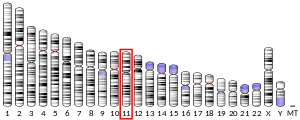| PHLDA2 | |||||||||||||||||||||||||||||||||||||||||||||||||||
|---|---|---|---|---|---|---|---|---|---|---|---|---|---|---|---|---|---|---|---|---|---|---|---|---|---|---|---|---|---|---|---|---|---|---|---|---|---|---|---|---|---|---|---|---|---|---|---|---|---|---|---|
| Identifiers | |||||||||||||||||||||||||||||||||||||||||||||||||||
| Aliases | PHLDA2, BRW1C, BWR1C, HLDA2, IPL, TSSC3, pleckstrin homology like domain family A member 2 | ||||||||||||||||||||||||||||||||||||||||||||||||||
| External IDs | OMIM: 602131 MGI: 1202307 HomoloGene: 2482 GeneCards: PHLDA2 | ||||||||||||||||||||||||||||||||||||||||||||||||||
| |||||||||||||||||||||||||||||||||||||||||||||||||||
| |||||||||||||||||||||||||||||||||||||||||||||||||||
| |||||||||||||||||||||||||||||||||||||||||||||||||||
| |||||||||||||||||||||||||||||||||||||||||||||||||||
| Wikidata | |||||||||||||||||||||||||||||||||||||||||||||||||||
| |||||||||||||||||||||||||||||||||||||||||||||||||||
Pleckstrin homology-like domain family A member 2 is a protein that in humans is encoded by the PHLDA2 gene.[5][6][7]
This gene is one of several genes in the imprinted gene domain of 11p15.5, which is considered to be an important tumor suppressor gene region. Alterations in this region may be associated with the Beckwith-Wiedemann syndrome, Wilms tumor, rhabdomyosarcoma, adrenocortical carcinoma, and lung, ovarian, and breast cancer. Studies of the mouse gene, however, which is also located in an imprinted gene domain, have shown that the product of this gene regulates placental growth.[7]
References
- 1 2 3 ENSG00000274538 GRCh38: Ensembl release 89: ENSG00000181649, ENSG00000274538 - Ensembl, May 2017
- 1 2 3 GRCm38: Ensembl release 89: ENSMUSG00000010760 - Ensembl, May 2017
- ↑ "Human PubMed Reference:". National Center for Biotechnology Information, U.S. National Library of Medicine.
- ↑ "Mouse PubMed Reference:". National Center for Biotechnology Information, U.S. National Library of Medicine.
- ↑ Qian N, Frank D, O'Keefe D, Dao D, Zhao L, Yuan L, Wang Q, Keating M, Walsh C, Tycko B (Dec 1997). "The IPL gene on chromosome 11p15.5 is imprinted in humans and mice and is similar to TDAG51, implicated in Fas expression and apoptosis". Hum Mol Genet. 6 (12): 2021–9. doi:10.1093/hmg/6.12.2021. PMID 9328465.
- ↑ Hu RJ, Lee MP, Connors TD, Johnson LA, Burn TC, Su K, Landes GM, Feinberg AP (Jan 1998). "A 2.5-Mb transcript map of a tumor-suppressing subchromosomal transferable fragment from 11p15.5, and isolation and sequence analysis of three novel genes". Genomics. 46 (1): 9–17. doi:10.1006/geno.1997.4981. PMID 9403053.
- 1 2 "Entrez Gene: PHLDA2 pleckstrin homology-like domain, family A, member 2".
Further reading
- Feinberg AP (1999). "Imprinting of a genomic domain of 11p15 and loss of imprinting in cancer: an introduction". Cancer Res. 59 (7 Suppl): 1743s–1746s. PMID 10197590.
- Maruyama K, Sugano S (1994). "Oligo-capping: a simple method to replace the cap structure of eukaryotic mRNAs with oligoribonucleotides". Gene. 138 (1–2): 171–4. doi:10.1016/0378-1119(94)90802-8. PMID 8125298.
- Suzuki Y, Yoshitomo-Nakagawa K, Maruyama K, et al. (1997). "Construction and characterization of a full length-enriched and a 5'-end-enriched cDNA library". Gene. 200 (1–2): 149–56. doi:10.1016/S0378-1119(97)00411-3. PMID 9373149.
- Lee MP, Feinberg AP (1998). "Genomic imprinting of a human apoptosis gene homologue, TSSC3". Cancer Res. 58 (5): 1052–6. PMID 9500470.
- Schwienbacher C, Sabbioni S, Campi M, et al. (1998). "Transcriptional map of 170-kb region at chromosome 11p15.5: Identification and mutational analysis of the BWR1A gene reveals the presence of mutations in tumor samples". Proc. Natl. Acad. Sci. U.S.A. 95 (7): 3873–8. Bibcode:1998PNAS...95.3873S. doi:10.1073/pnas.95.7.3873. PMC 19930. PMID 9520460.
- Frank D, Mendelsohn CL, Ciccone E, et al. (2000). "A novel pleckstrin homology-related gene family defined by Ipl/Tssc3, TDAG51, and Tih1: tissue-specific expression, chromosomal location, and parental imprinting". Mamm. Genome. 10 (12): 1150–9. doi:10.1007/s003359901182. PMID 10594239. S2CID 10021238.
- Müller S, van den Boom D, Zirkel D, et al. (2000). "Retention of imprinting of the human apoptosis-related gene TSSC3 in human brain tumors". Hum. Mol. Genet. 9 (5): 757–63. doi:10.1093/hmg/9.5.757. PMID 10749982.
- Frank D, Fortino W, Clark L, et al. (2002). "Placental overgrowth in mice lacking the imprinted gene Ipl". Proc. Natl. Acad. Sci. U.S.A. 99 (11): 7490–5. Bibcode:2002PNAS...99.7490F. doi:10.1073/pnas.122039999. PMC 124258. PMID 12032310.
- Saxena A, Morozov P, Frank D, et al. (2003). "Phosphoinositide binding by the pleckstrin homology domains of Ipl and Tih1". J. Biol. Chem. 277 (51): 49935–44. doi:10.1074/jbc.M206497200. PMID 12374806.
- Strausberg RL, Feingold EA, Grouse LH, et al. (2003). "Generation and initial analysis of more than 15,000 full-length human and mouse cDNA sequences". Proc. Natl. Acad. Sci. U.S.A. 99 (26): 16899–903. Bibcode:2002PNAS...9916899M. doi:10.1073/pnas.242603899. PMC 139241. PMID 12477932.
- Saxena A, Frank D, Panichkul P, et al. (2004). "The product of the imprinted gene IPL marks human villous cytotrophoblast and is lost in complete hydatidiform mole". Placenta. 24 (8–9): 835–42. doi:10.1016/S0143-4004(03)00130-9. PMID 13129680.
- Gerhard DS, Wagner L, Feingold EA, et al. (2004). "The Status, Quality, and Expansion of the NIH Full-Length cDNA Project: The Mammalian Gene Collection (MGC)". Genome Res. 14 (10B): 2121–7. doi:10.1101/gr.2596504. PMC 528928. PMID 15489334.
- Kim HS, Roh CR, Chen B, et al. (2007). "Hypoxia regulates the expression of PHLDA2 in primary term human trophoblasts". Placenta. 28 (2–3): 77–84. doi:10.1016/j.placenta.2006.01.025. PMID 16584773.
- Beausoleil SA, Villén J, Gerber SA, et al. (2006). "A probability-based approach for high-throughput protein phosphorylation analysis and site localization". Nat. Biotechnol. 24 (10): 1285–92. doi:10.1038/nbt1240. PMID 16964243. S2CID 14294292.
- Apostolidou S, Abu-Amero S, O'Donoghue K, et al. (2007). "Elevated placental expression of the imprinted PHLDA2 gene is associated with low birth weight". J. Mol. Med. 85 (4): 379–87. doi:10.1007/s00109-006-0131-8. PMID 17180344. S2CID 24292385.
- Tang KF, Wang Y, Wang P, et al. (2007). "Upregulation of PHLDA2 in Dicer knockdown HEK293 cells". Biochim. Biophys. Acta. 1770 (5): 820–5. doi:10.1016/j.bbagen.2007.01.004. PMID 17303335. S2CID 30622597.
- Bertheau P, Turpin E, Rickman DS, et al. (2007). "Exquisite Sensitivity of TP53 Mutant and Basal Breast Cancers to a Dose-Dense Epirubicin−Cyclophosphamide Regimen". PLOS Med. 4 (3): e90. doi:10.1371/journal.pmed.0040090. PMC 1831731. PMID 17388661.
This article is issued from Wikipedia. The text is licensed under Creative Commons - Attribution - Sharealike. Additional terms may apply for the media files.




